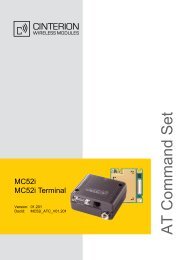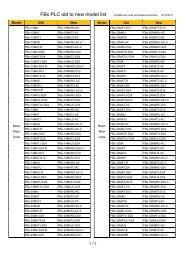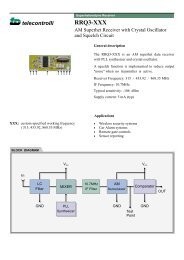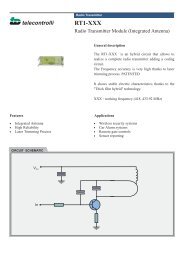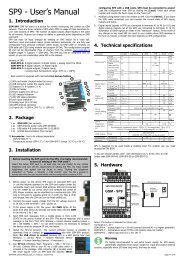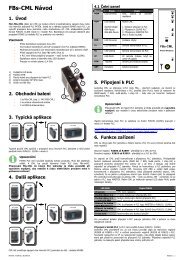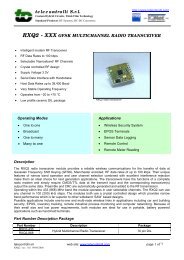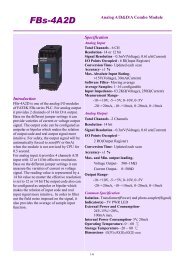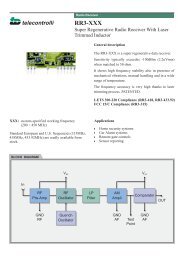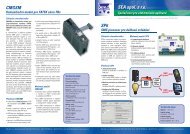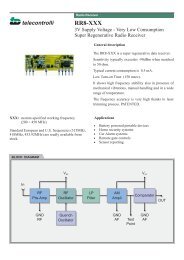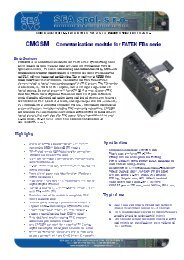Chapter 21 Temperature Measurement of FBs-PLC and PID Control
Chapter 21 Temperature Measurement of FBs-PLC and PID Control
Chapter 21 Temperature Measurement of FBs-PLC and PID Control
Create successful ePaper yourself
Turn your PDF publications into a flip-book with our unique Google optimized e-Paper software.
FUN86<br />
TPCTL<br />
Convenient Instruction <strong>of</strong> <strong>PID</strong> <strong>Temperature</strong> <strong>Control</strong><br />
FUN86<br />
TPCTL<br />
Oper<strong>and</strong><br />
Md<br />
Yn<br />
Sn<br />
Zn<br />
Range<br />
Y HR ROR DR K<br />
Y0<br />
∣<br />
Y255<br />
○<br />
R0<br />
∣<br />
R3839<br />
R5000<br />
∣<br />
R8071<br />
D0<br />
∣<br />
D3999<br />
Sv ○ ○* ○<br />
Os ○ ○* ○<br />
PR ○ ○* ○<br />
IR ○ ○* ○<br />
DR ○ ○* ○<br />
OR ○ ○* ○<br />
WR ○ ○* ○<br />
0~1<br />
0~31<br />
1~32<br />
Md : Selection <strong>of</strong> <strong>PID</strong> method<br />
=0, Modified minimum overshoot method<br />
=1, Universal <strong>PID</strong> method<br />
Yn : Starting address <strong>of</strong> <strong>PID</strong> ON/OFF output;<br />
it takes Zn points.<br />
Sn : Starting point <strong>of</strong> <strong>PID</strong> control <strong>of</strong> this instruction;<br />
Sn = 0~31.<br />
Zn : Number <strong>of</strong> the <strong>PID</strong> control <strong>of</strong> this instruction;<br />
1≤ Zn ≤32 <strong>and</strong> 1 ≤ Sn+Zn ≤ 32<br />
Sv : Starting register <strong>of</strong> the setpoint;<br />
it takes Zn registers. (Unit in 0.1°)<br />
Os : Starting register <strong>of</strong> the in-zone <strong>of</strong>fset;<br />
it takes Zn registers. (Unit in 0.1°)<br />
PR : Starting register <strong>of</strong> the gain (Kc);<br />
it takes Zn registers.<br />
IR :Starting register <strong>of</strong> integral tuning constant (Ki);it<br />
takes Zn registers.<br />
DR : Starting register <strong>of</strong> derivative tuning constant<br />
(Td); it takes Zn registers.<br />
OR : Starting register <strong>of</strong> the <strong>PID</strong> analog output;<br />
it takes Zn registers.<br />
WR: Starting <strong>of</strong> working register for this instruction.<br />
It takes 9 registers <strong>and</strong> can’t be repeated in<br />
using.<br />
● By employing the temperature module <strong>and</strong> table editing method to get the current value <strong>of</strong> temperature <strong>and</strong> let<br />
it be as so called Process Variable (PV); after the calculation <strong>of</strong> s<strong>of</strong>tware <strong>PID</strong> expression, it will respond the<br />
error with an output signal according to the setting <strong>of</strong> Set Point (SP),the error's integral <strong>and</strong> the rate <strong>of</strong> change<br />
<strong>of</strong> the process variable. Through the closed loop operation, the steady state <strong>of</strong> the process may be expected.<br />
● Convert the output <strong>of</strong> <strong>PID</strong> calculation to be the time proportional on/<strong>of</strong>f (PWM) output, <strong>and</strong> via transistor output<br />
to control the SSR for heating or cooling process; this is a good performance <strong>and</strong> very low cost solution.<br />
● Through the analog output module (D/A module), the output <strong>of</strong> <strong>PID</strong> calculation may control the SCR or<br />
proportional valve to get more precise process control.<br />
● Digitized <strong>PID</strong> expression is as follows:<br />
n<br />
M n =[Kc × E n ]+∑ [K c × K i × T s × E n ]+[K c × T d × (PV n − PV n-1 )/T s ]<br />
0<br />
M n : Output at time “n”.<br />
K c : Gain (Range: 1~9999;Pb=1000 / Kc ×0.1%, Unit in 0.1%)<br />
K i : Integral tuning constant (Range:0~9999, equivalent to 0.00~99.99 Repeat/Minute)<br />
T d : Derivative tuning constant (Range:0~9999, equivalent to 0.00~99.99 Minute)<br />
PVn : Process variable at time “n”<br />
PVn − 1 : Process variable when loop was last sovled<br />
E n : Error at time “n” ; E= SP – PVn<br />
T s : Solution interval for <strong>PID</strong> calculation (Valid value are 10, 20, 40, 80,160, 320; the unit is in 0.1Sec)<br />
<strong>21</strong>-12



